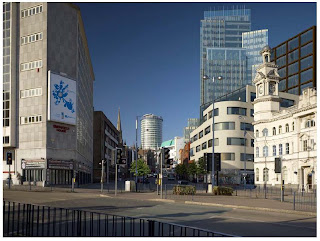107m Digbeth Tower for the home of the people of Beorma
Following my earlier post on Council Leader Whitby's Arab adventure for Birmingham and his meeting Salhia managing directors, Salhia's development Beorma Quarter has been submitted into planning.
Beorma Quarter refers to Beorma and the origin of the name Birmingham. Adrian Room's Placenames of the World explains that "Britain's second largest city has an Old English name that could be that of any small village. It means "homestead at the place named after Beorma." It is not known who Beorma was, but his name is a shortened form of Beornmund".
The plans reveal the scope of the development; Beorma Quarter, a mixed use development comprising the refurbishment of the Digbeth Coldstore building, retention of the facades of 138 and 139 Digbeth and the construction of three new blocks including a 27 storey tower at 107m tall.

An excerpt from the planning application is shown below:
The report of the Chairman of the Planning Committee to a forthcoming Council meeting in February has revealed that "Subject to all the necessary consents being agreed, work could start later in the year."
Development of the scheme will throw up it's own challenges though with BACTEC International undertaking an Explosive Ordnance Threat Assessment of the Cold Store, Digbeth, Birmingham. The assessment comes from the fact the site is close to sites that were primary bombing targets of the Luftwaffe and that on a Birmingham bomb census map bombs fell in the areas surrounding the boundaries of the Beorma Quarter site.
We need not panic though as they note that several buildings built prior to the war survive alongside buildings developed after the war suggesting the risk that unexploded ordinances would be remain within the site is small. The consideration reveals the important history attached to the site and the important central role Digbeth plays in the history and development of Birmingham.
Rendered images of the proposed development from the planning application are shown below.












Beorma Quarter refers to Beorma and the origin of the name Birmingham. Adrian Room's Placenames of the World explains that "Britain's second largest city has an Old English name that could be that of any small village. It means "homestead at the place named after Beorma." It is not known who Beorma was, but his name is a shortened form of Beornmund".
The plans reveal the scope of the development; Beorma Quarter, a mixed use development comprising the refurbishment of the Digbeth Coldstore building, retention of the facades of 138 and 139 Digbeth and the construction of three new blocks including a 27 storey tower at 107m tall.

An excerpt from the planning application is shown below:
Date application received
23/01/2009
Date application registered
23/01/2009
Status
Under Consultation
Location
123-143 Digbeth, 3-5 Park Street, 81-93 Alison Street, and adjoining land, Digbeth, Birmingham, B5 6DR
Proposal
Mixed use development comprising refurbishment of the Digbeth Coldstore building, 135-136 and 137 Digbeth, façade of 138 and 139 Digbeth and construction of three new blocks including a 27 storey tower to provide shops, offices, restaurant and cafe (A1, A2 and A3), business space (B1), residential (C3) and exhibition space (D1), together with an energy centre using an aquifer thermal energy storage system (ATES), basement parking and creation of new landscape areas. (sic)
The report of the Chairman of the Planning Committee to a forthcoming Council meeting in February has revealed that "Subject to all the necessary consents being agreed, work could start later in the year."
Development of the scheme will throw up it's own challenges though with BACTEC International undertaking an Explosive Ordnance Threat Assessment of the Cold Store, Digbeth, Birmingham. The assessment comes from the fact the site is close to sites that were primary bombing targets of the Luftwaffe and that on a Birmingham bomb census map bombs fell in the areas surrounding the boundaries of the Beorma Quarter site.
We need not panic though as they note that several buildings built prior to the war survive alongside buildings developed after the war suggesting the risk that unexploded ordinances would be remain within the site is small. The consideration reveals the important history attached to the site and the important central role Digbeth plays in the history and development of Birmingham.
Rendered images of the proposed development from the planning application are shown below.














Comments